The Flying Ghost Galaxy (NGC 520) is a pair of colliding galaxies located in the constellation Pisces. The interacting duo has an apparent magnitude of 12.2 and an apparent size of 5.09596 by 1.94309 arcminutes. It lies approximately 105 million light-years away.
NGC 520 is believed to consist of two galactic disks that are in an early stage of merger. The interacting system has a diameter of 103,500 light-years. It has two velocity systems and two smaller tails. Two galactic nuclei were detected by S. A. Stanford and M. Balcells, Department of Astronomy, University of Wisconsin, in 1990. One of these is an H II nucleus, an active galactic nucleus (AGN) with a region of ionized atomic hydrogen.
The strong gravitational interaction between the two spiral galaxies has left both galaxies severely disrupted. Most of the resulting starburst activity is taking place in the larger galaxy and drives a powerful galactic wind. The two galaxies are separated by a lane of dust.
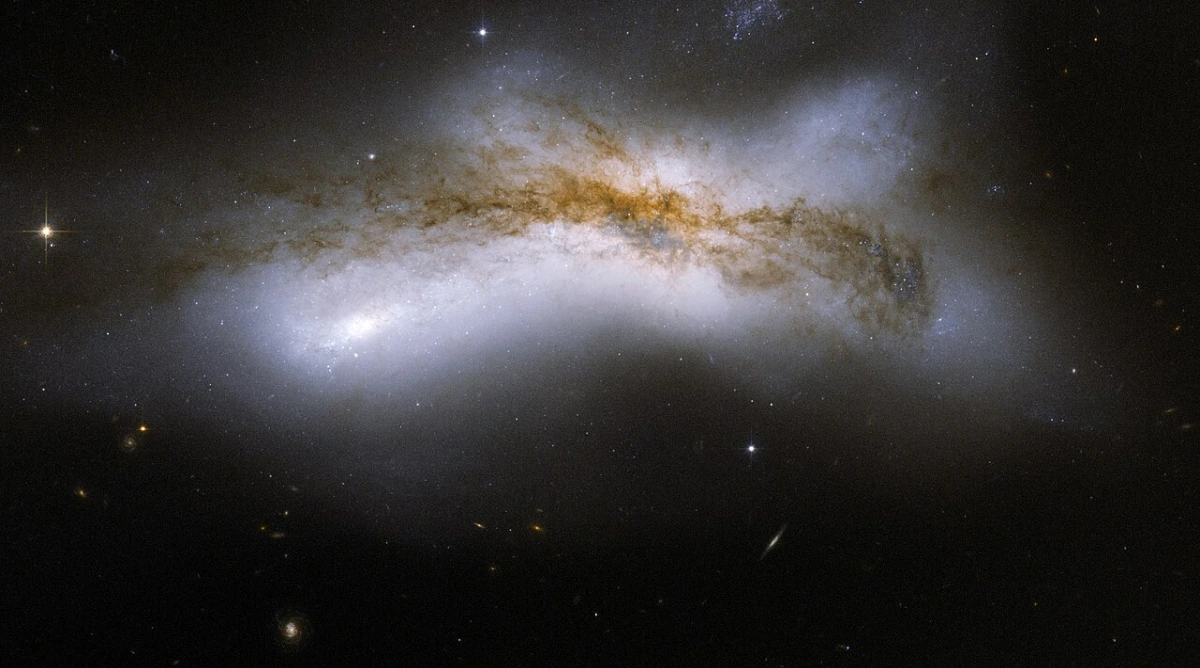
NGC 520 is the product of a collision between two disk galaxies that started 300 million years ago. It exemplifies the middle stages of the merging process: the disks of the parent galaxies have merged together, but the nuclei have not yet coalesced. It features an odd-looking tail of stars and a prominent dust lane that runs diagonally across the center of the image and obscures the galaxy. NGC 520 is one of the brightest galaxy pairs on the sky, and can be observed with a small telescope toward the constellation of Pisces, the Fish, having the appearance of a comet. It is about 100 million light-years away and about 100,000 light-years across. The galaxy pair is included in Arp’s catalog of peculiar galaxies as Arp 157. This image is part of a large collection of 59 images of merging galaxies taken by the Hubble Space Telescope and released on the occasion of its 18th anniversary on 24th April 2008. Image credit: NASA, ESA, the Hubble Heritage (STScI/AURA)-ESA/Hubble Collaboration, and B. Whitmore (STScI) (PD)
Simulations have shown that the two galactic disks likely started interacting around 300 million years ago. The encounter triggered increased star formation outside the core regions of the two galaxies.
The more massive main component appears to the southeast and the secondary to the northwest. The more massive galaxy is optically faint because it appears edge-on and much of its light from the central region is absorbed by dust in its disk, which appears as a dark dust lane. The smaller galaxy appears brighter.
Observations with the Chandra X-ray Observatory in 2005 revealed that the galaxies glow with only half the luminosity expected for their evolutionary merger state. Astronomers have found the larger galaxy to have a gas-rich disk and the smaller one, a gas-poor disk. Even though the close encounter triggered enhanced star formation in both galaxies 300 million years ago, the gas-rich more massive galaxy still has a higher rate of ongoing star formation. Its star formation rate is around 35 times higher than that of an isolated disk galaxy. The star formation in the smaller galaxy has returned to a normal level.
Two dwarf galaxy candidates lie near the colliding pair. One of them, UGC 957, appears in the northern tidal tail and may be a product of the merger. Tidal dwarf galaxies like UGC 957 appear as blue luminous knots in tidal tails produced by galactic collisions. They form from debris in merging galaxies and are regions of active star formation.
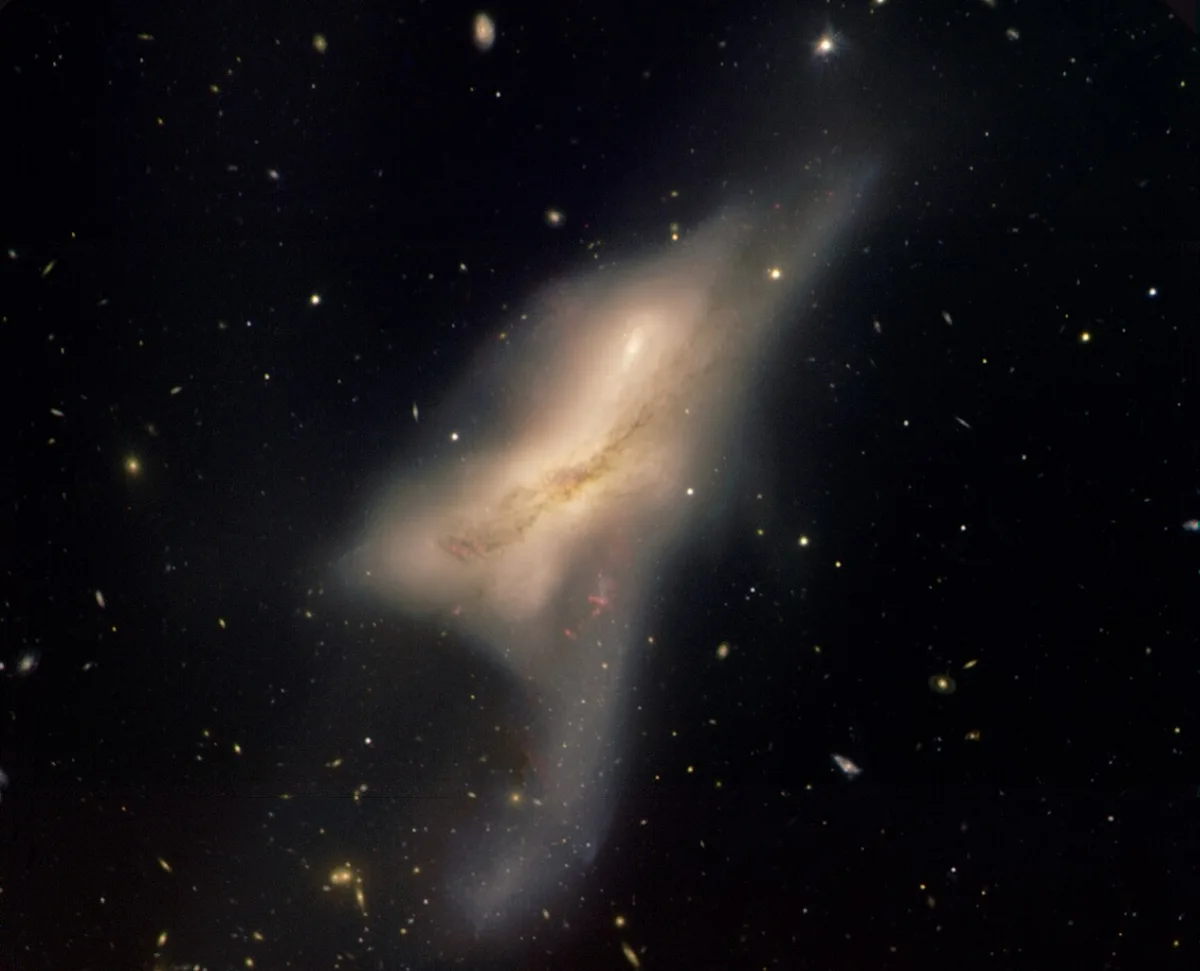
Gemini North image of interacting galaxies NGC 520. NGC 520 has a unique shape that is the result of two galaxies colliding with each other. One galaxy’s dust lane can be seen easily in the foreground and a distinct tail is visible at bottom center. These features are a result of the gravitational interactions that have robbed both of the galaxies of their original shapes. Some astronomers speculate that each member of the pair was originally similar to the Milky Way and Andromeda Galaxy. This collision could be providing us a glimpse at what might happen to our own galaxy in about five billion years as the Andromeda Galaxy collides with our Milky Way. Estimated to lie some 100 million light-years away in the direction of the constellation Pisces, these galaxies have likely changed significantly in the time it has taken for their light to reach us. This view may be fairly early in the galactic dance that these galaxies have been performing. Hints of star formation (faint red glowing areas above and beneath the middle of the image) may have become more pronounced during the course of the collision. Many background galaxies also appear in this image. They represent galaxy evolution at an even earlier epoch in the history of the universe. Image credit: International Gemini Observatory (CC BY 4.0)
Facts
NGC 520 was discovered by the German-born British astronomer William Herschel on December 13, 1784.
Astronomers were long uncertain about the nature of the peculiar galaxy. Some believed it to be a system similar to the starburst galaxy Messier 82 (the Cigar Galaxy), while others suspected it was a pair of galaxies in the process of merging. As late as the 1960s, Edwin Hubble, Erik Holmberg, and other prominent figures thought that NGC 520 was a single galaxy.
The puzzle was resolved by 1990, when Stanford and Balcells identified the two nuclei, a counterrotating gas disk in the larger galaxy, and a long tidal tail pulled from the galaxy.
NGC 520 is listed as Arp 157 in American astronomer Halton Arp’s Atlas of Peculiar Galaxies (1966). Arp noted that the object was the second brightest very disturbed galaxy in the sky. At infrared and radio wavelengths, NGC 520 appears as bright as the better-known Antennae Galaxies (Arp 244) in the constellation Corvus (the Crow).
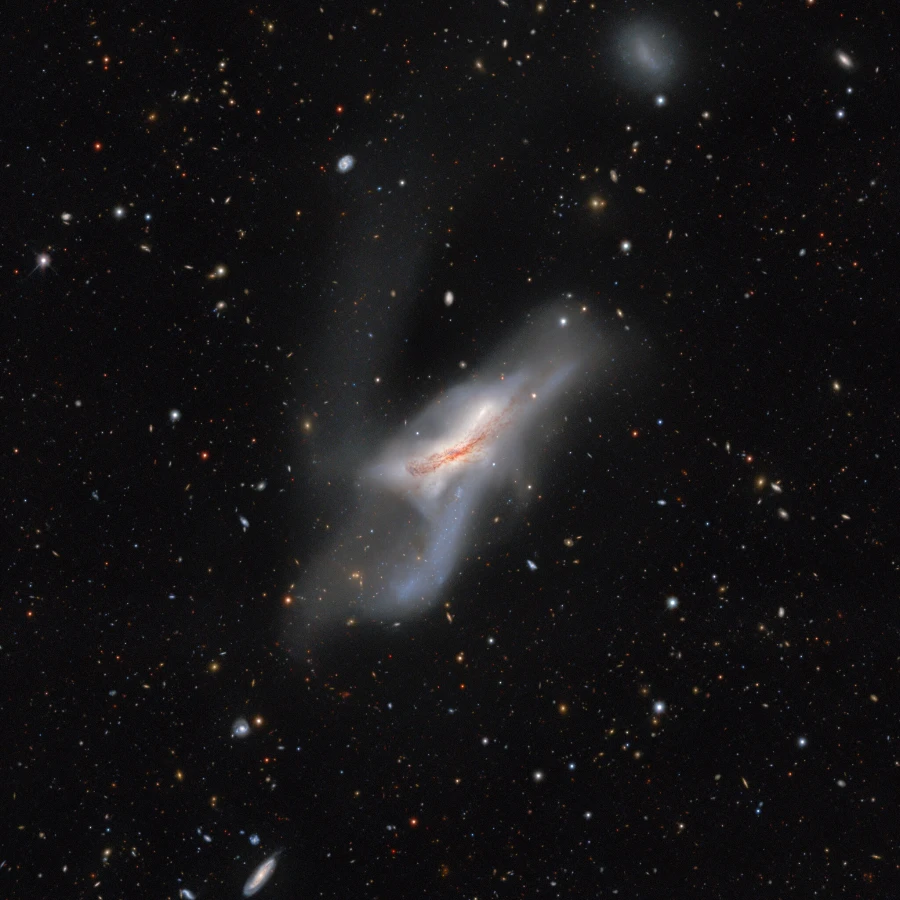
A galactic collision of two galaxies which began more than 300 million years ago, NGC 520 is actually made up of two disk galaxies which will eventually merge together to form one larger, more massive system. NGC 520 was discovered by William Herschel in 1784 and is one of the largest and brightest galaxies in the Siena Galaxy Atlas. Image: CTIO/NOIRLab/DOE/NSF/AURA; Acknowledgments: PI: J. Moustakas (Siena College); Image Procesing: T.A. Rector (University of Alaska Anchorage/NSF’s NOIRLab) & M. Zamani (NSF’s NOIRLab) & D. de Martin (NSF’s NOIRLab) (CC BY 4.0)
NGC 520 hosted a supernova, SN 2025zjx, observed on September 29, 2025. SN 2025zjx was classified as a Type II supernova, triggered by the core collapse of a massive star. It had an apparent visual magnitude of 21.68. It was discovered by the Panoramic Survey Telescope and Rapid Response System (Pan-STARRS) at Haleakala Observatory in Hawaii.
The Simbad database lists NGC 520 as a member of a group of galaxies that lie at a similar distance. The group includes the elliptical galaxy NGC 474, the spiral galaxies NGC 470, NGC 488, NGC 489, NGC 485, NGC 518, NGC 522, and NGC 532, and the lenticular galaxies NGC 502, NGC 509, NGC 516, and NGC 524. The unbarred lenticular galaxy NGC 467 appears close to NGC 470 and NGC 474 in the sky, but lies at more than twice the distance and is not believed to be part of the group.
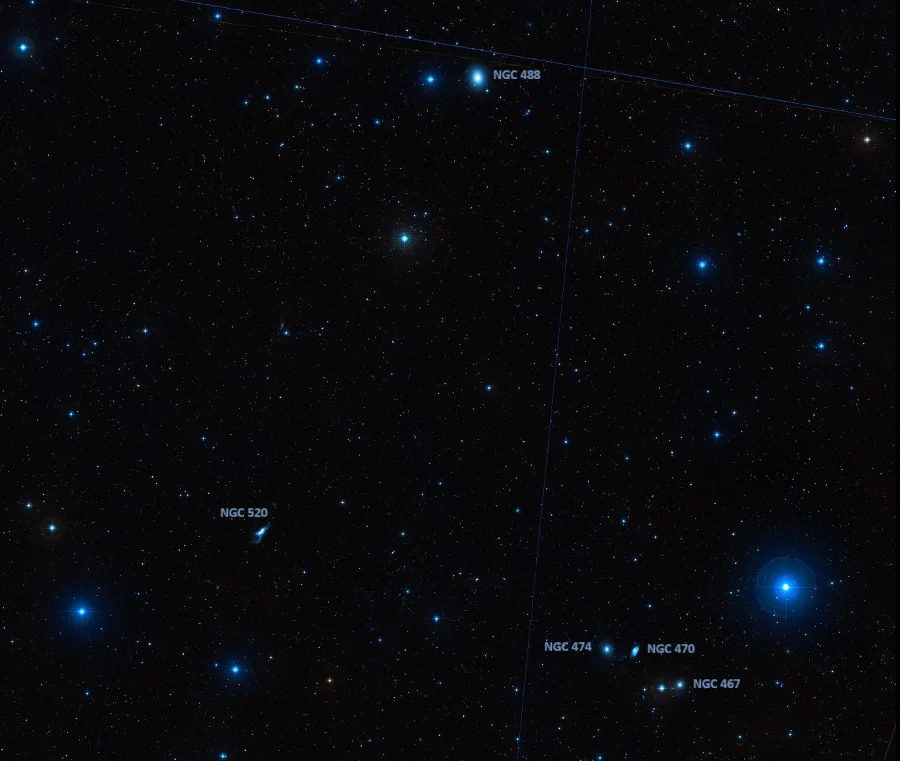
NGC 520, NGC 470, NGC 474, NGC 488 and NGC 467, image credit: ESO/Digitized Sky Survey 2 (CC BY 4.0)
Location
The Flying Ghost Galaxy lies in the faint zodiac constellation of Pisces (the Fishes), near the border with Cetus (the Sea Monster). The galactic pair appears a little less than halfway between Alpherg, the brightest star in Pisces, and Eta Ceti in Cetus. Alpherg can be identified using the brighter Hamal and Sheratan in Aries, and Eta Ceti and the brighter Diphda can be found using the Great Square of Pegasus. NGC 520 appears around 2.5 degrees south-southwest of Mu Piscium.
With an apparent magnitude of 11.4, NGC 520 can be spotted in small and medium telescopes on a clear, dark night. Larger telescopes will reveal the dark dust lane.
At declination +03° 47 ′, NGC 520 lies close enough to the celestial equator to be visible from virtually anywhere for at least part of the year. The best time to observe deep sky objects in Pisces is during the month of November, when the constellation is higher above the horizon around 9 pm.
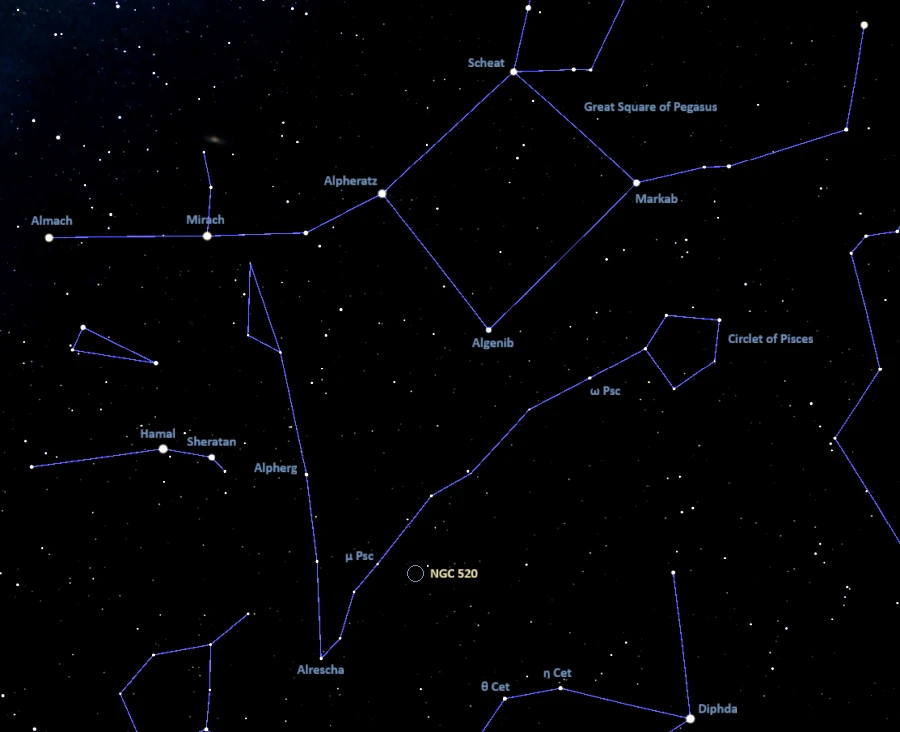
Flying Ghost Galaxy location, image: Stellarium
Flying Ghost Galaxy – NGC 520
| Constellation | Pisces |
| Object type | Colliding galaxies |
| Morphological type | Pec or Sa |
| Right ascension | 01h 24m 35.07120s |
| Declination | +03° 47′ 32.6760″ |
| Apparent magnitude | 12.2 |
| Apparent size | 5.09596′ × 1.94309′ |
| Distance | 105 million light-years (32.2 megaparsecs) |
| Redshift | 0.007359 ± 0.000010 |
| Heliocentric radial velocity | 2,198 ± 3 km/s |
| Size | ~103,500 ly (31.74 kpc) |
| Names and designations | Flying Ghost Galaxy, NGC 520, LEDA 5193, PGC 5193, UGC 966, MCG +01-04-052, Arp 157, APG 157, IRAS 01219+0331, Arp 157, CGCG 411-050, VV 231, BWE 0121+0332, FIRST J012434.9+034729, PMN J0124+0348, GLEAM J012434+034736, GB6 B0121+0332, NVSS J012434+034729, PRC D-44, 87GB 012159.6+033202, IRAS 01219+0331, IRAS F01219+0331, 2MASX J01243507+0347326, [CAB95] IRAS F01219+0331, KPG 31, ISOSS J01245+0347, PSCz Q01219+0331, [CHM2007] HDC 67 J012435.07+0347326, [CHM2007] LDC 85 J012435.07+0347326, WB 0121+0332, TXS 0121+035, Z 411-50, Z 0122.1+0333, [DC78] UGC 966, [NKB95] N0520, [HDL96] 385 14, [HSN2016] J021.14+03.79, [M98c] 012159.4+033213, [SLK2000] 9, [SLK2004] 195 |